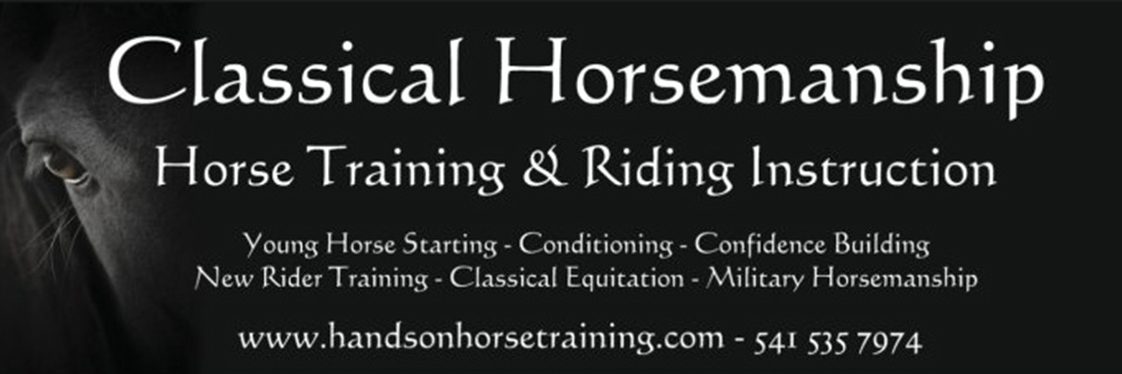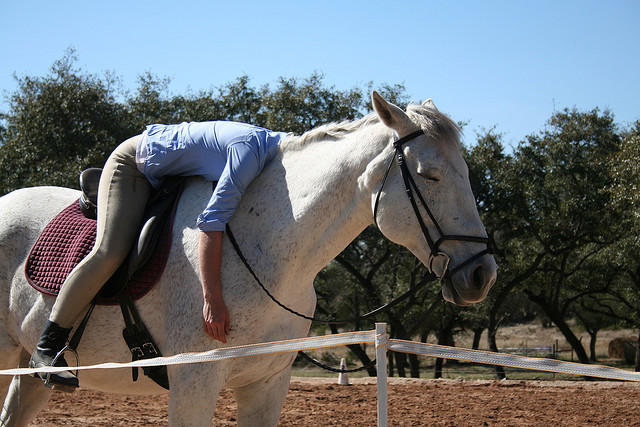The Myth of the Quiet Horse
or why ‘relaxed and calm’ is not always preferable
Yes, here I go again, with the cryptic titles. “What on earth is he on about this time? He is now going to find fault with my calm, relaxed horse?”
I sometimes wish I had been brought up speaking some language other than English, because what our language lacks in precision it more than makes up for in situational variability. Relaxed and Calm, like so many other terms we cast about freely when we talk about riding, i.e. Light and Gentle and Firm, are two words that mean different things to different people and should be examined in order to come to a common understanding if we are to discuss which mental states of the horse are to be sought and which to be avoided.
To many, Relaxed and Calm are synonymous and mean at ease and not nervous, but sometimes what they take to be Relaxed and Calm, is in fact disconnected and unresponsive. Many riders seek to put their horse into such a relaxed state that they avoid really working or any pressure, so as to not upset the horse or make it nervous. Seeking a stress-free experience, they want the horse to be as quiet under saddle as it is standing in the pasture. ‘And what is wrong with that?’ you might ask. There is nothing wrong with the goal per se, the problem occurs when the horse either becomes sluggish and disconnected from the rider or worst of all, learns that if it misbehaves the rider will back off and no progress is made.
Additionally, some riders equate quiet with fearless. They sit up on the horse’s back as it walks along the trail, reins draped across the pommel, legs hanging lifelessly, sitting slouched in the saddle, trusting the quiet horse to haul them around. The horse, walking along with other calm horses, seems perfectly relaxed and completely safe. Suddenly something moves out nearby or some loud crash is heard off in the trees and one horse starts, then the horse next to it jumps, and suddenly the usually quiet and calm horse has wheeled and begun moving, very fast, away from the perceived threat. By the time the rider has realized something is wrong, they are scrambling to pick up their reins, find their seat, and get their legs back in play, all while trying to keep from losing their balance. The sudden return of the aids and probable over-application that accompanies a fear of falling off, just adds to the horse’s belief that something dangerous is going on and matters can quickly get out of hand.
A consistent connection with the horse is a cornerstone of classical riding and an important factor in any riding. The classical rider is never ‘not riding’ when they are on the back of a horse. Even while standing still, talking to someone, adjusting their tack, or just enjoying the view from a hilltop, the classical rider should never be disconnected from their horse. The reins are kept at or close to the same contact they use while actively riding. The rider should be upright and balanced in the seat and the legs resting lightly against the horse’s sides just as they do when the horse is being actively ridden. Yes, we will all take our legs off the horse, stand in the stirrups, or let the reins go slack for a moment to stretch and get the blood flowing into tired limbs, but then we should reconnect with our horse afterward. As classical riders, we are always synced with our horse so this state of connection should be as natural and automatic for us as keeping our balance when we walk. In this way the confidence that we impart to our horses as riders is never more than a fraction of a second away. A correctly closed hand or supporting leg can stop a startled horse from becoming a fleeing horse and the stability the classical seat gives us can mean the difference between being present to give those countering cues and looking up painfully from the ground as our horse runs off down the trail or to the far end of the arena. In fact, this is exactly the term I use with my students, “Being Present”. Any time we are in the saddle, we should be Present.
It is not just a matter of safety however, a horse ridden in such a way as to have no demands placed on it whatsoever will inevitably become ‘quiet’ to the point of almost sleepwalking its way through the ride. Too ‘relaxed’ and the horse loses impulsion in the gaits and shuffles along under the rider, numb to the cues and always trying to stop. A horse in this state is not being trained in any useful way. Yes, a collected trot or stretching walk can relax a nervous horse but done too often or too long, or even worse, with no call for good forward movement, engagement, and driving impulsion, can create a ‘quiet horse’ that creeps around the arena, feet barely moving, with no tempo to work with and a mind not on the training.
At the other extreme, too often the method of dealing with ‘nervous’ or ‘excited’ horses is to run them around a round pen or on a lunge line to tire them out until they ‘calm down’; this is simply counter-productive. Tiring out a nervous horse does not get you a calm horse, it only gets you a tired, nervous horse. An exhausted horse may be ‘quieter’, but it cannot move properly or respond correctly to the aids. It can also make the horse dread being worked and in the long run, only makes matters worse. Horses do not willfully defy us. Regardless of anecdotal evidence to the contrary, horses only respond as they have evolved to respond and a nervous or excited horse has a reason for being that way. We cannot punish them out of it or run it out of them.
Only through consistent, flexible aids can a horse become aware of the rider’s aim. Only a properly conditioned and balanced horse can meet the physical demands placed on it and remain calm and engaged. Demanding more than a horse can give at any moment in its training will create resistance; forcing the horse through this resistance can create defiance; trying to break defiance destroys trust; without trust, there can never be calm.
So I have talked a lot about what ‘relaxed’ and ‘calm’ are not, so what do I think they are?
In German, there is this great term I have difficulty pronouncing properly, “Losgelassenheit”. It means a state where the horse is calm, willing, connected, and engaged. Lieutenant Colonel Gustav von Dreyhausen defined the term thusly; “We can therefore perhaps characterize correct equestrian Losgelassenheit as a type of behavior in which the horse yields completely to the rider’s aids and applies all of his strength and all of his muscles towards the energetic and impulsive execution of the present demands without feeling constricted.” While this definition doesn’t even use the word ‘calm’, it is implied because the free giving of the horse to the aids requires a calm and mentally engaged horse.
Too often a horse is described as not being calm because it has a lot of energy or is very quick to react to the aids, when in fact is it is perfectly relaxed, focused, and totally in sync with its rider. Such a horse may display an outward appearance that people have come to associate with an excited or scared horse, like upright carriage and lofty, energetic movement, while in reality, it is neither scared nor unduly excited. Highly athletic horses and horses that truly enjoy what they are doing, often display this behavior. In fact, at its pinnacle, classical dressage seeks to achieve just this carriage and response from the horse. As long as the horse is willing to respond to light aids and the wishes of the rider and is not being forced or held in check, such a horse can be said to still be displaying Losgelassenheit, even if most would not use the word ‘calm’ to describe it.
Many riders can be intimidated by a horse displaying the traits I just mentioned and prefer to ride a horse that is more still, giving an outward appearance of being quiet, because it helps them feel more confident; I have no problem with this. The problem comes when the confidence-inspiring state the rider seeks comes at the cost of impulsion and connection or is taken advantage of by the horse in order to avoid working.
What classical riding advocated is very simple to say but difficult to achieve; a connection that creates the willingness on the horse’s part to respond to the clear, gentle, and just requests of the rider, without fear of punishment as the motivation, but rather from an instinctive and automatic reaction created by the practiced communication through consistent and subtle use of the aids; losgelassenheit.
True quiet and calm must come from trust and a thorough connection with the horse. This connection has to exist in both directions and not just from rider to horse. We have to be tuned in to the movement of the horse and aware of its mental and emotional nature to translate what we feel into comprehension and turn that comprehension into a reasoned response. We also must remember that the horse feels our emotional state through this connection as well. If we are nervous, excited, or afraid, they will know it; therefore it is incumbent on us to learn to control these emotions in ourselves before asking them of them. This way the horse and rider become a partnership, with both party’s feelings, needs, and desires taken into account. The rider must always seek lighter and more subtle connections as a way of making the reactions of the horse instinctive responses to the subtle cues the aids provide and NOT based on the avoidance of discomfort or pain. The horse in such a partnership, through trust and respect of the rider, gains confidence and focus which are key to remaining responsive and calm at all times.
Reaching this goal takes a long time, a lot of riding and the help of an educated pair of eyes on the ground to offer observations and instruction. The aids must become as automatic and natural as waking. It requires a focus on the goal not being sidetracked by ego, fear, or frustration. When it becomes about the rider and not about the connection with the horse we fall behind. When we do not require of the horse its commitment to the ride and obedience to the just demand, we fall behind. When we ask for too much at one time or exhaust the horse, mentally or physically, we fall behind.
So the next time you ride, pause to take stock of your horse’s mental state and give a thought to what quiet and calm really mean.

